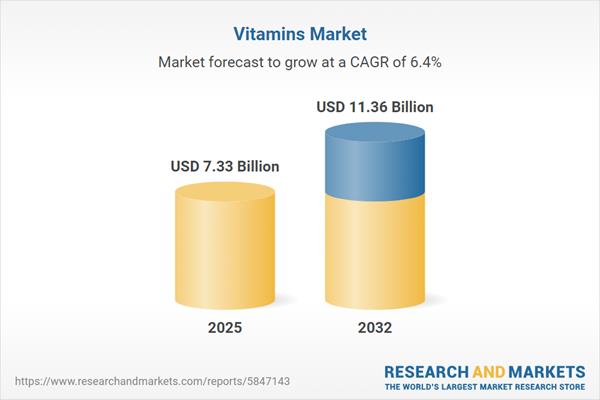Speak directly to the analyst to clarify any post sales queries you may have.
The vitamins market is evolving rapidly, driven by changing health priorities, technological innovation, and emerging regulatory frameworks. Senior executives seeking growth opportunities need clear insight into shifting consumer demands and the operational landscape influencing market success.
Market Snapshot: Vitamins Market Growth and Outlook
The global vitamins market grew from USD 6.90 billion in 2024 to USD 7.33 billion in 2025. With an anticipated CAGR of 6.41%, the market is forecasted to reach USD 11.36 billion by 2032. Expansion is propelled by rising consumer healthcare awareness, regulatory changes favoring transparency, and widespread e-commerce adoption. Geographic variation, evolving user preferences, and supply chain adaptation are reshaping the competitive landscape for producers and distributors alike.
Scope & Segmentation
This report provides a comprehensive analysis of the vitamins market, delving deep into product, form, source, application, user, distribution channel, regional, and company dynamics. Key segmentation areas include:
- Product Types: Multivitamins, B Complex (Vitamin B1, B12, B2, B3, B5, B6, B9), Vitamin A, C, D, E, K, and single vitamin products
- Form Factors: Capsules, gummies, liquid, powder, softgels, and tablets
- Source Types: Natural and synthetic vitamins
- Applications: Preventive and therapeutic use, including bone health, heart health, and immune support
- End Users: Adult, geriatric, and pediatric consumers
- Distribution Channels: Hospitals & clinics, pharmacies & drugstores, supermarkets & hypermarkets, as well as brand-owned and e-commerce websites
- Regions Assessed: Americas (United States, Canada, Mexico, Brazil, Argentina, Chile, Colombia, Peru), Europe, Middle East & Africa (United Kingdom, Germany, France, Russia, Italy, Spain, Netherlands, Sweden, Poland, Switzerland, UAE, Saudi Arabia, Qatar, Turkey, Israel, South Africa, Nigeria, Egypt, Kenya), and Asia-Pacific (China, India, Japan, Australia, South Korea, Indonesia, Thailand, Malaysia, Singapore, Taiwan)
- Technology Innovations: Blockchain-enabled traceability, encapsulation for enhanced bioavailability, digital health integration, and sustainable sourcing
- Leading Companies: Abbott Laboratories, BASF SE, DSM-Firmenich AG, Pfizer Inc., GlaxoSmithKline PLC, Archer Daniels Midland, and others
Key Takeaways: Strategic Insights for Decision-Makers
- Consumer demand is shifting toward personalized vitamins, with digital platforms enabling tailored supplementation based on health data and genetic insights.
- Sustainability requirements are compelling manufacturers to innovate sourcing strategies and adopt clean-label and plant-based alternatives, bolstering brand differentiation and regulatory compliance.
- Investment in supply chain resilience, including supplier diversification and regional partnerships, is proving crucial in mitigating risk and maintaining consistent ingredient flow.
- Innovative delivery formats, such as gummies and softgels, are capturing younger demographics, while liquid forms gain traction for consumers seeking rapid absorption and convenience.
- Regional differences, including regulatory frameworks and consumer health priorities, necessitate localized product positioning and strategic adaptation to maximize market penetration.
- Strategic collaborations and digital transformation, such as the integration of blockchain verification and AI-powered demand planning, are expediting product launches and improving supply chain transparency.
Tariff Impact: Navigating Cost Structures and Sourcing Challenges
The updated tariffs coming into effect in 2025 will increase import costs for vitamins and raw materials in the United States. In response, manufacturers are actively diversifying sourcing regions—including Latin America and Southeast Asia—and increasing domestic production capacity to buffer against escalated duties. Over the short term, these changes may compress margins and prompt companies to reposition premium offerings, while also leading to greater scrutiny of incentive programs and regulatory adjustments. Strategic agility is key for stakeholders facing tariff-driven market fluctuations.
Methodology & Data Sources
This vitamins market research incorporates primary interviews with executives, scientists, supply chain experts, and regulators. Secondary sources include peer-reviewed journals, trade publications, and official regulatory databases. Data triangulation enhances validity, while expert validation ensures findings align with real-world practices and policy shifts.
Why This Report Matters
- Provides actionable insights to help senior leaders anticipate market shifts and make informed decisions.
- Enables benchmarking against key competitors and technology trends, supporting differentiated growth strategies.
- Equips stakeholders with in-depth segment, regional, and supply chain analysis for resilient business planning.
Conclusion
The vitamins market offers opportunities for innovation, operational resilience, and sustainable growth through informed, technology-enabled strategies. Effective adaptation to evolving consumer, regulatory, and sourcing dynamics will define success for forward-thinking leaders.
Additional Product Information:
- Purchase of this report includes 1 year online access with quarterly updates.
- This report can be updated on request. Please contact our Customer Experience team using the Ask a Question widget on our website.
Table of Contents
3. Executive Summary
4. Market Overview
7. Cumulative Impact of Artificial Intelligence 2025
Companies Mentioned
The companies profiled in this Vitamins market report include:- Abbott Laboratories
- Alkem Laboratories Ltd.
- Amway Corporation
- Archer-Daniels-Midland Company
- BASF SE
- Systopic Laboratories Pvt Ltd
- Cadila Pharmaceuticals Ltd.
- Cipla Limited
- Dishman Carbogen Amcis Limited
- Divi’s Laboratories Ltd.
- Dr. Reddy's Laboratories Ltd.
- DSM-Firmenich AG
- FDC Limited
- Fermenta Biotech Ltd.
- Glanbia PLC
- GlaxoSmithKline PLC
- Intas Pharmaceuticals Ltd.
- Integrace Pvt Limited
- Macleods Pharmaceuticals Pvt Ltd.
- Mankind Pharma Ltd.
- Meyer Organics Pvt Ltd.
- Nature’s Bounty by Nestlé S.A.
- Novus Life Sciences Pvt Ltd.
- Pfizer Inc.
- Pharmed Ltd.
- Sanofi S.A.
- Synthesia, A.S.
- Herbalife Nutrition Ltd.
- Botanic Healthcare Group
Table Information
| Report Attribute | Details |
|---|---|
| No. of Pages | 193 |
| Published | November 2025 |
| Forecast Period | 2025 - 2032 |
| Estimated Market Value ( USD | $ 7.33 Billion |
| Forecasted Market Value ( USD | $ 11.36 Billion |
| Compound Annual Growth Rate | 6.4% |
| Regions Covered | Global |
| No. of Companies Mentioned | 30 |









